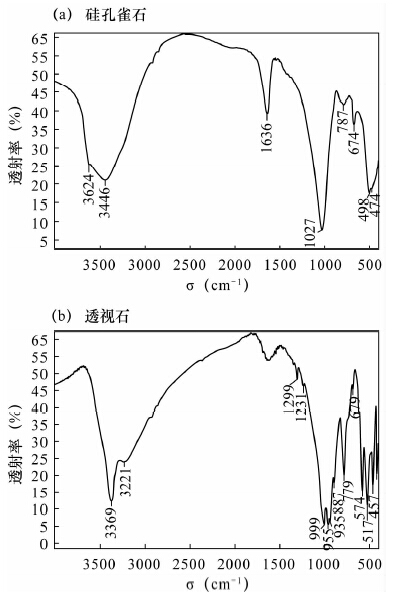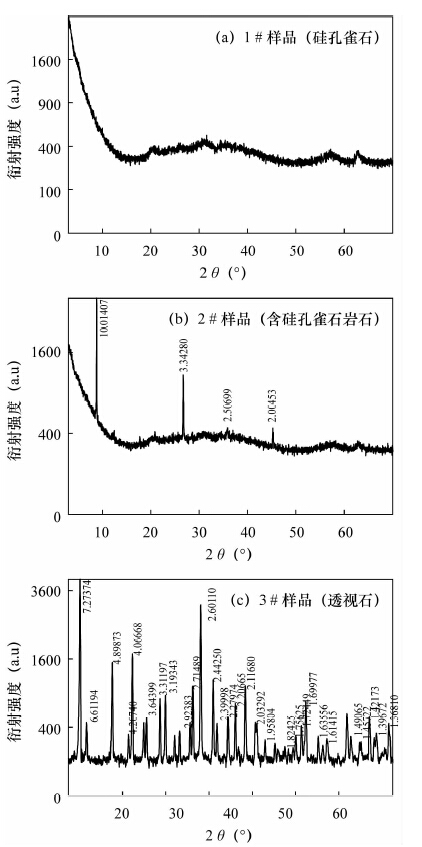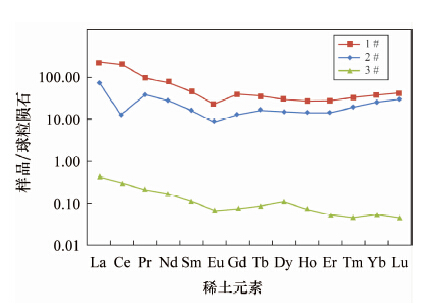Geochemical Characteristics of Rare Earth Elements in Chrysocolla and Dioptase and Their Metallogenetic Environments
-
摘要: 硅孔雀石和透视石是在热液成矿作用下经过水-岩反应形成的产物, 但这一认识缺少稀土地球化学研究成果的支持。本文通过电感耦合等离子体质谱分析获得两种矿物的稀土元素含量, 其中硅孔雀石的稀土含量较低(∑REEs=81.2 mg/kg), 透视石的稀土含量极低(∑REEs=0.65 mg/kg); 两者轻重稀土间分馏较为显著, LREEs/HREEs=3.01和6.05, (La/Yb)N=3.08和7.91。球粒陨石标准化的稀土元素配分模式图均表现为轻微“负铕异常”(δEu=0.565和0.702)、轻稀土富集、重稀土稳定的右倾特征, 表明两者物质来源于同一物体。硅孔雀石显著“负铈异常”(δCe=0.219), 透视石无“负铈异常”(δCe=0.949), 应为两者晶体结构差异所致。研究认为, 硅孔雀石和透视石中的稀土元素继承了成矿岩石的稀土特征, 证实了两者是在同一氧化条件下通过水-岩反应形成的产物。

-
关键词:
- 硅孔雀石 /
- 透视石 /
- 稀土元素地球化学特征 /
- 成矿环境 /
- 电感耦合等离子体质谱法
Abstract: Chrysocolla and dioptase were considered to be formed from hydrothermal solutions by fluid-rock interaction, but this view was not verified by REE geochemistry. In this study, the REEs contents in these two minerals were determined by Inductively Coupled Plasma-Mass Spectrometry (ICP-MS). Results show that chrysocolla has total REEs of 81 mg/kg, whereas dioptase has total REEs of 0.65 mg/kg. There is obvious fractionation of LREEs from HREEs for chrysocolla and dioptase with LREEs/HREEs ratios of 3.01 and 6.05, and (La/Yb)N ratios of 3.08 and 7.91, respectively. The chondrite-normalized REEs patterns of two minerals show weak Eu anomalies with δEu of 0.565 and 0.702, respectively, with LREEs enrichment and flat HREEs, indicating their similar source. Obvious Ce anomaly (δCe=0.219) of chrysocolla and no Ce anomaly (δCe=0.949) of dioptase are possibly due to their different crystal structures. Chrysocolla and dioptase inherit the REEs characteristics of the source rocks. These two minerals were formed by fluid-rock interaction under the same oxidized condition. -
随着我国经济的发展,占镍用途65%的不锈钢需求增长迅速,镍需求的年增长率在7%以上。世界上可开采的镍资源按地质成因分为岩浆型硫化镍矿和风化型氧化镍矿,氧化镍矿由于铁的氧化呈现红色,亦称为红土镍矿。目前,60%的镍是从硫化镍矿中提取。然而,随着品位高、开采条件好的硫化镍矿资源日趋枯竭,人们对具有勘查、采矿成本低,可直接生产氧化镍、镍锍和镍铁等产品的红土镍矿日益关注[1, 2, 3, 4, 5]。2006年开始,我国进口红土镍矿数量剧增,全年共进口红土镍矿377.7万吨,同比增长681%;2007年全年进口镍矿超过1500万吨,其中90%以上为红土镍矿[2, 6]。胡顺峰等[2]针对世界红土镍矿资源的分布和资源特点、典型红土镍矿的成分及主要品质评价指标(Ni、Co、Fe、MgO、SiO2等)进行了总结。红土镍矿的主要成分见表 1[2, 6, 7]。不同的生产工艺对红土镍矿的各项指标要求不同,各项目标元素的检测一般依据贸易合同要求进行[3],其准确检测对于贸易结算中的公平交易和纠纷处理、生产过程中的工艺选择及试料配比具有重要意义[8, 9]。
表 1 红土镍矿主要成分Table 1. The main components of nickel laterite组分 含量(%) 组分 含量(%) Fe 7~56 TiO 0.004~0.09 SiO2 4~50 Cr2O3 0.8~5 MgO 0.5~35 Ni 0.3~3 Al2O3 1~9 Cu 0~0.01 CaO 0.03~3 P 0~0.03 MnO 0.1~0.4 Co 0.02~0.2 分析红土镍矿中主量、次量、痕量元素的样品前处理方式主要有酸溶法、碱熔法、压片法、熔片法和水蒸气蒸馏法;检测方法有电感耦合等离子体发射光谱法(ICP-AES)、原子吸收光谱法(AAS)、X射线荧光光谱法(XRF)、电感耦合等离子体质谱法(ICP-MS)、原子荧光光谱法(AFS)、分光光度法(UV-Vis)和容量法等。近年来,红土镍矿中各项目标元素的检测研究工作逐步推进,已经形成了YS/T 820系列和SN/T 2763系列行业标准以及大量研究报道。然而相同的检测项目存在多种测试方法,以Ni的分析为例,可利用酸溶法、碱熔法、压片法、熔片法进行前处理,利用ICP-AES、AAS、XRF、UV-Vis等方法检测,且部分相同原理的测试方法存在细节上的差异,使得方法使用者难以选择合适的检测方法。
本文针对红土镍矿中24种元素(Al、As、Bi、C、Ca、Cd、Cl、Co、Cr、Cu、F、Fe、Hg、Mg、Mn、Ni、P、Pb、S、Sb、Sc、Si、Ti、Zn)的分析,总结了各类样品前处理方式和分析测定技术,对各种检测方法的适用性、存在问题和发展方向进行阐述,以期相关检测实验室在日常检测过程中可根据实验条件选择合适的检测方法。
1. 红土镍矿常规检测项目
红土镍矿可分为褐铁矿型和硅镁镍矿型,其主量成分为Fe、Si、Mg。通常情况下,水分、Ni、Fe、P、Co为红土镍矿贸易中最关注的检测项目,也是重要的计价项目[1, 6],少数还有对Mg、Al、Si、Cr、S等元素的要求。为使检测工作更好地服务于生产和贸易,分析工作者也建立了红土镍矿中As、Bi、C、Ca、Cd、Cl、Cu、F、Hg、Mn、Pb、Sb、Sc、Ti、Zn等元素的分析方法。
各个元素对于红土镍矿品质的影响主要取决于冶炼工艺及冶炼产品的用途。一般情况下,冶炼红土镍矿生产的镍铁主要用于钢铁生产,因此,Ni、Co、Fe、Cr等4种元素的含量越高,红土镍矿的品质越好,但是氨浸法处理工艺不适合处理Co含量高的红土镍矿。Si、Mg、Al等元素在红土镍矿处理过程中增加原材料消耗从而增加成本,高含量的P在钢铁中容易引起钢铁的冷脆性且不易除去,S元素在钢铁中容易引起钢的热脆性。因此,一般而言,红土镍矿中的Si、Mg、Al、P、S等5种元素的含量越低越好[2]。
2. 红土镍矿样品前处理方法
选择合适的样品分解方法以保证目标元素全部进入待测溶液是实现准确测定的关键。综合考虑矿物类型、目标分析元素及检测手段,可利用酸溶法、碱熔法、压片法、熔片法和水蒸气蒸馏法对红土镍矿进行前处理。其中,酸溶法和碱熔法用途最广,主要用于ICP-AES、AAS、ICP-MS、AFS、UV-Vis和容量法测定相关元素的前处理过程;压片法和熔片法用于XRF测定红土镍矿中的部分元素[10, 11, 12, 13, 14, 15];水蒸气蒸馏法则用于离子色谱法测定F和Cl[14]。本文重点讨论酸溶法和碱熔法。
2.1 酸溶法和碱熔法
2.1.1 酸溶法
酸溶法是用酸在加热条件下破坏样品中的有机物或还原性物质的方法[16]。消解过程温度一般较低,不容易与容器发生反应,而且引入的盐分少,操作简单,适用范围较广。应用酸溶法分解红土镍矿,主要采用盐酸-硝酸-氢氟酸-高氯酸四酸溶样。盐酸可缓慢地溶解褐铁矿,而用王水分解红土镍矿的能力更高。氢氟酸对含硅高的岩矿分解能力显著,提高了Al、Ba、Cu、Fe、Na和Ti等易被Si吸附元素的分析准确度[17]。高氯酸不仅氧化性强而且沸点高,在分解试样的同时,常被用于冒烟除去分解试液中过量的氟以利于后续的分析测试。通常使用6~20 mL盐酸、2~10 mL硝酸(盐酸与硝酸的体积比一般为3:1或3:2)、2 ~10 mL氢氟酸、0.5~5 mL高氯酸消解红土镍矿,用于测定Ni、Co、Zn、Cu、Ca、Mg、Mn、Pb、Zn、Cd、Al、P、Sc等元素。
但是,酸溶法在分解过程中易导致挥发元素的损失。As、Sb、Bi、Hg易挥发,Cr易随高氯酸冒烟损失,这5个元素并不适合采用高温下高氯酸冒烟除氟的前处理方法,可以采用王水[18]或硝酸、氟化氢铵和硫酸[19]分解试样进行测定。
2.1.2 碱熔法
碱熔法的分解能力强,碱熔试剂中的过氧化钠几乎可以分解所有的岩矿,而无水碳酸钠是分解硅酸盐类岩矿的经典熔融试剂。碱熔法分解红土镍矿的熔剂有过氧化钠、碳酸钠-过氧化钠、碳酸钠-四硼酸钠、碳酸钠-硼酸、氢氧化钾、氢氧化钠。碳酸钠与其他熔剂组成的混合熔剂有很强的分解能力,但需注意对铂器皿的腐蚀。氢氧化钾和氢氧化钠的吸湿性很强,故分解时容易起泡喷溅,尤其是氢氧化钾。为了防止试样溅失,通常先在坩埚内熔融适量熔剂[12]或熔融时先在电炉上烤去水分[14, 20]。考虑到各熔剂对器皿的腐蚀性及测定目标元素的准确性,需要在选定熔样熔剂后,正确选用恰当的坩埚。
碱熔法通常用于红土镍矿中Cu、Zn、Cr、Ni、Co、Ca、Mg、Al、Ti、Si、全铁的测定。
2.1.3 酸溶法与碱熔法处理红土镍矿的比较
酸溶法引入的盐分少,操作简单,但是分解过程中易导致挥发元素的损失。碱熔法分解能力强,但熔样会引入大量的盐类和因坩埚材料损耗而带入其他杂质,给后续分析带来困难。李波等、周凯等、李昌丽等分别利用分光光度法测定红土镍矿中Ni[21]、原子吸收光谱法(AAS)测定Zn[22, 23]、Cu[7],对比了酸溶法和碱熔法的测定效果,结果显示2种样品分解方法所测结果基本一致。
在分析Cr、Si、全铁等项目时,碱熔法因其分解能力强而比酸溶法更为有效,从而保证了测定结果的准确性。
2.2 红土镍矿样品前处理方法存在的问题
Cr的前处理方法可采用碱熔法[23]、酸溶-焦硫酸钾熔融残渣法[23]或磷酸-硫酸-硝酸-高氯酸溶样法[24]。针对Cr的3种前处理方法,碱熔法和酸溶-焦硫酸钾熔融残渣法引入的盐分均较多,容易烧结堵塞燃烧缝口;而磷酸-硫酸-硝酸-高氯酸溶样法中需要引入黏度较高的磷酸和硫酸,在实际应用过程中也有一定缺陷。已报道的3种方法均利用AAS测定,不能和其他元素同时测定,发展一种可同时分析Cr和其他元素的前处理方法将是新的研究目标。
尽管酸溶法和碱熔法在红土镍矿中的应用非常普及,但是这2种方法因需要使用较多化学试剂从而引入更多试剂污染,而且高温处理造成操作繁琐、易挥发元素损失等缺点。微波消解技术因具有试剂消耗少、样品分解完全、挥发性元素损失小等特点可有效地避免以上问题,已被广泛应用于金属矿产样品的消解,但应用于处理红土镍矿较少,且局限于其中元素Ni的测定[25]。因此,利用微波消解处理红土镍矿的方法还需要进一步探索。
3. 红土镍矿分析测定技术
红土镍矿的分析测定技术有ICP-AES、AAS、XRF、UV-Vis和容量法、ICP-MS、AFS等。同一目标元素可以利用多种技术进行检测,实验室可依据实际情况选择合适的元素分析方法,从而实现成本低、速度快、高准确、高灵敏、高通量的检测。
在元素测定过程中需要注意红土镍矿本身易吸水的特点,这决定了红土镍矿中部分元素的准确测定需要在样品烘干之后尽快进行或者与测定同步进行湿存水量的分析[14, 15]。同时,水分的准确测定在红土镍矿的贸易结算中也非常重要。
3.1 现代和经典分析测定技术
3.1.1 电感耦合等离子体发射光谱法
已报道使用ICP-AES检测红土镍矿中的Al、Ca、Cd、Cr、Co、Cu、Mg、Mn、Ni、P、Pb、Si、Ti、Zn,其中大多数元素的检测下限为10-4级,P和Cu的检测下限可达到10-5级[6, 14, 15, 25, 26, 27, 28]。理论上通过稀释消解液,ICP-AES可测定红土镍矿中测定下限以上的所有含量,但是过度稀释引入的误差过大,且在测定高含量元素时需要选择不同灵敏度的分析谱线、线性范围等因素,因此,一般情况下ICP-AES的测定上限小于30%。
利用ICP-AES测定红土镍矿中目标元素的研究重点在于前处理方法的选择和干扰的消除。对于干扰,可通过选择合适的分析谱线[6, 25, 26, 27, 28]、添加铁基体[6, 28]、使用内标[25, 26]等方法消除。通过研究1000 μg/mL Fe、1000 μg/mL Ca、500 μg/mL Si和1000 μg/mL Mg对1 μg/mL Co、Cu、Ni的干扰,表明高含量的红土镍矿基体并不影响Co、Cu、Ni的测定(图 1)[26]。10~50 μg/mL Fe对1 μg/mL Ca、Cd、Co、Cu、Mg、Mn、Ni、Pb、Zn等9种元素的测定无明显干扰[27],而铁对低含量目标元素的干扰情况尚无法确定。在针对铁矿石的研究中,结果表明铁基体(1.4 mg/mL)的加入使各待测元素曲线的斜率较纯标准曲线的斜率有不同程度的降低, 两组斜率最大的要相差19.8%, 两组截距也各不相同(表 2)[29]。铁基体这种对谱线强度的抑制作用主要与其物理干扰有关, 即大量铁存在使溶液的盐分、黏度、表面张力增大, 引起溶液吸喷速率减少及雾化效率降低, 使参与蒸发、激发的原子和离子数目减少而最终导致元素谱线信号减弱, 曲线的斜率下降[29]。由此可见,干扰的来源并不主要源于主量元素Fe的光谱干扰,而是源于物理干扰。既然属于物理干扰,则可以通过添加内标消除,但是应该考虑到红土镍矿产地和品种的多样性,某些矿种含有所用内标元素反而引入误差。因此,为了确保检测结果的准确性,通过基体匹配消除干扰的普适性更强。
表 2 铁基体对待测元素测定的影响Table 2. Effect of iron matrix on element determination元素 a1/a2 b1-b2 元素 a1/a2 b1-b2 Ca 0.926 3.03 As 0.929 -0.105 Mg 0.952 -0.413 Zn 0.811 3.356 Al 0.984 -3.16 Cr 0.944 -0.682 Mn 0.864 -5.82 V 0.902 0.424 Cu 0.947 1.08 Ti 0.946 0.241 Pb 0.861 0.642 Co 0.859 -0.459 Ni 0.802 -1.54 Cd 0.887 -1.19 注:a1为加基体标准系列标准曲线的斜率,a2为纯标准系列标准曲线的斜率;b1为加基体标准系列标准曲线的截距,b2为纯标准系列标准曲线的截距。 3.1.2 火焰原子吸收光谱法
红土镍矿中采用的原子吸收光谱法主要为火焰原子吸收光谱法(FAAS),该方法属于单元素测定方法,主要用于红土镍矿中10-4~10-2级别低沸点、易原子化的元素(如Ca、Mg、Ni、Co、Zn、Cr、Cd、Mn、Pb)的测定[7, 22, 23, 24, 30]。对于Al、Si、Ti等难熔元素,该方法的检出限偏高,不适用于红土镍矿中相应元素的测定。目前,大多数矿产实验室均配备该仪器,因此普适性非常强,但随着实验室仪器配置的提高,该方法所承担的分析元素逐渐减少。
3.1.3 X射线荧光光谱法
XRF主要用于红土镍矿中含量为10-3~1级别的元素(如Al、Ca、Cr、Co、Fe、K、Mg、Mn、Ni、P、S、Si、Ti、V)的测定[10, 11, 12, 13],其中Co、P、Ca、Cr、Ti、Mn等元素的检测下限可达到10-4级别。通过测定元素可以看出,该方法可准确测定Al、Si、Ti、V等难熔元素和P。
XRF的样品前处理不同于其他方法,一般采用粉末压片法和熔融法。粉末压片法简便快捷,操作简单,但是存在严重的矿物效应和颗粒效应;熔融法可以消除矿物效应和颗粒效应。而在高温下,红土镍矿中单质类物质硅、铁等与铂金生成合金,严重腐蚀铂金坩埚,因此熔融法在实际分析中受到限制。彭南兰等[13]比较了压片法和熔融法应用于测定红土镍矿中Al、Ca、Cr、Co、Fe、Mg、Mn、Ni和Si元素的效果,对于压片法,通过采用康普顿散射线作内标和经验系数法校正基体效应,可准确测定红土镍矿中除Mg和Si以外的7种元素;对于熔融法,通过采用理论α影响系数法校正基体效应,可准确测定红土镍矿中9种目标元素。
XRF是一种相对分析的方法,其准确性在很大程度上依赖于一套高质量的标准样品。一般采用与待测样品性质相近的校准样品绘制曲线,但是在实际检测过程中相应的标准样品较少,因此,针对经常检测性质相似的红土镍矿的实验室或炉前检测,该法快速简便。但XRF要求具备较多的校准样品且实验操作人员经验丰富,使得此方法在红土镍矿测样量小的实验室的适用性有限。
3.1.4 分光光度法
UV-Vis一般仅能测定一个元素,在红土镍矿检测中主要用于Ni[21, 31, 32]和P[14]的测定。
分光光度法测定Ni的主要原理为试样经消解后,以酒石酸钾钠作掩蔽剂,在氢氧化钠介质中,以过硫酸铵作氧化剂,镍与丁二酮肟生成可溶性酒红色络合物,于合适的波长处测定Ni的含量。在样品溶液中加入氢氧化钠溶液,使溶液处于强碱性,可以增强过硫酸铵的氧化能力,将Ni2+更加充分地氧化为Ni4+,从而使Ni4+与丁二酮肟显色完全,生成酒红色络合物。过硫酸铵溶液加入量不足时,显色反应速度慢,且显色不完全,过量时络合物又被破坏,导致吸光度降低。因此,过硫酸铵的用量需准确加入[21]。
UV-Vis应用于测定红土镍矿中Ni的研究集中于干扰消除,由于Cu2+、Co2+等离子与丁二酮肟可以生成有色络合物,Fe3+、Al3+、Mg2+、Cr3+等离子在碱性介质中容易生成氢氧化物沉淀,因此实验中在加入氢氧化钠之前应先加入酒石酸盐与上述离子络合,从而起到掩蔽试样溶液中共存金属离子的作用。李波等[21]提出在460 nm波长处以不加丁二酮肟显色剂的试剂作参比消除干扰。王彤等[32]则选择灵敏度较低的530 nm为测定波长消除干扰。褚宁等[31]研究结果显示,当干扰离子含量高于待测元素Ni含量100~500倍时,加入20 mL 200 g/L酒石酸钾钠溶液,这些干扰离子不影响Ni的测定。
UV-Vis测定红土镍矿中P的经典方法为磷钼蓝光度法,即试样经盐酸、硝酸、氢氟酸分解,用高氯酸冒烟赶氟,并将偏磷酸氧化为正磷酸。在硫酸介质中,在硝酸铋的催化下,磷酸与钼酸铵形成磷钼黄,以抗坏血酸将磷钼黄还原成磷钼蓝,于分光光度计波长690 nm处测定其吸光度[14]。鉴于实验试剂在检测中的作用原理不同,硝酸铋、钼酸铵以及抗坏血酸的添加顺序不能变更,且加完每种试剂之后均应立即充分混匀后再加入下一种试剂。
3.1.5 电感耦合等离子体质谱法和原子荧光光谱法
ICP-MS最突出的特点是具有极高的灵敏度(检出限可达10-15级别),可用于红土镍矿中痕量和超痕量元素的分析。利用ICP-MS可测定红土镍矿中10-6~10-4级别的Sc和Cd[14]。然而ICP-MS受多原子离子干扰以及进样溶液中溶解性总固体不大于0.1%的限制,导致通常使用的四酸溶样法和碱熔法在其应用中受限,因此需要研究恰当的样品前处理方式以匹配快速发展的ICP-MS分析技术。
AFS属于单元素测定方法,主要用于分析红土镍矿中10-5~10-3级别且易形成气态氢化物的元素,如As、Bi、Sb[18, 19]。
目前,关于ICP-MS和AFS在红土镍矿中的应用报道并不多。
3.2 红土镍矿分析测定技术的比较
XRF、ICP-AES、ICP-MS为多元素分析方法,检测下限依次降低。3种方法各有侧重。XRF在测定主含量元素Fe和P、Si等方面更优。ICP-AES测定范围较宽,更适合于主量、次量元素的分析,相比于XRF对含量较低元素(如Cd、Cu、Pb、Zn等)的检测更有优势。ICP-MS与ICP-AES在技术应用上有一定的互补,最适合测定痕量或超痕量的重元素,特别是稀土元素和贵金属元素。
容量法、AAS、UV-Vis和AFS(双通道仪器可同时测定两种元素)为单元素测定方法,相应的仪器设备为实验室的常规配置,在缺乏XRF、ICP-AES、ICP-MS等大型仪器的实验室,这些方法可分别用于相应元素的检测。AAS可准确测定Al、Si、Ti、V等难熔元素和P,这些元素是ICP-AES的检测弱项。AFS适合测定As、Hg、Sb、Bi等易形成气态氢化物的元素,而应用ICP-MS测定As受多原子离子干扰严重,相较之下,AFS测定As时优于ICP-MS。
基于以上讨论,本文将红土镍矿中各元素前处理技术、分析测定方法及相应的干扰消除方式汇总于表 3,以方便分析工作者根据实验条件选择合适的检测方法。
表 3 红土镍矿样品前处理方法和分析测定技术Table 3. Sample preparation methods and analytical techniques for nickel laterite测定元素 前处理方法 测定技术 测定干扰消除 文献 Ca,Mg 酸溶法:0.1 g试样,以20 mL盐酸-10 mL硝酸-5 mL氢氟酸-5 mL高氯酸分解。以盐酸溶解盐类 FAAS Ca 422.7 nm、Mg 285.2 nm。测镁时试液中添加0.002%氯化锶;测钙时试液中添加0.001%氯化锶 [14] Cd 酸溶法:0.2 g试样,以15 mL盐酸-5 mL硝酸-5 mL氢氟酸-3 mL高氯酸分解。以硝酸溶解盐类 FAAS Cd 228.8 nm [14] Co 酸溶法:0.2 g试样,以20 mL盐酸-10 mL硝酸-5 mL氢氟酸-5 mL高氯酸分解。以盐酸溶解盐类 FAAS Co 240.7 nm [14] Co,Ni 酸溶法:0.1~0.5 g试样,以5 ~10 mL氢氟酸,5 ~10 mL现配王水,0.5 ~1 mL高氯酸分解。以盐酸溶解盐类 FAAS Co 240.7 nm、Ni 232.0 nm或352.3 nm [15] Cr 酸溶法:0.2 g试样,以2 mL磷酸-2 mL硫酸-5 mL硝酸-2 mL高氯酸分解 FAAS Cr 357.9 nm;采用空气-乙炔贫焰;铁基体匹配标液及空白;加入硫酸钠-氯化铵作为干扰抑制剂 [24] Cr,Cu,Zn 酸溶法:0.5 g试样,以15 mL盐酸-5 mL硝酸-5 mL氢氟酸-1 mL高氯酸分解。以硝酸溶解盐类。
碱熔法:0.5 g试样,以1.3 g碳酸钠-2.7 g过氧化钠800℃熔融,20 mL盐酸浸提。采用刚玉坩埚。
酸溶-焦硫酸钾熔融残渣法:0.5 g试样,以30 mL盐酸-10 mL硝酸分解,残渣用5~6 g焦硫酸钾700℃熔融,热水浸提。采用铂坩埚FAAS Cr 357.9 nm、Cu 324.8 nm、Zn 213.9 nm [7, 23] Cu 酸溶法:0.5 g试样,以15 mL盐酸-5 mL硝酸-5 mL氢氟酸-1 mL高氯酸分解。以硝酸溶解盐类 FAAS Cu 324.8 nm [14] Mn 酸溶法:0.1~0.2 g试样,以10 mL盐酸-5 mL硝酸-5 mL氢氟酸-2 mL高氯酸分解。以盐酸溶解盐类 FAAS Mn 279.5 nm [14] Ni 酸溶法:0.1 g试样,以6 mL盐酸-2 mL硝酸-2 mL氢氟酸-1 mL高氯酸分解。以盐酸溶解盐类 FAAS Ni 232.0 nm [14] Ni 酸溶法:0.1 g试样,以15 mL盐酸-5 mL硝酸分解。以盐酸溶解盐类。
碱熔法:0.1 g试样,以1 g过氧化钠600℃熔融,15 mL浓盐酸洗出坩埚FAAS Ni 232.0 nm [30] Pb 酸溶法:0.1~0.5 g试样,以15 mL盐酸-5 mL硝酸-5 mL氢氟酸-2 mL高氯酸分解。以硝酸溶解盐类 FAAS Pb 283.3 nm [14] Zn 酸溶法:0.1 g试样,以6 mL盐酸-2 mL硝酸-2 mL氢氟酸-0.5 mL高氯酸分解。以盐酸溶解盐类。
碱熔法:0.1 g试样,以4 g过氧化钠750℃熔融,20 mL 25%盐酸和1滴双氧水浸提。采用刚玉坩埚FAAS Zn 213.9 nm对于锌量小于0.05%,且铁量大于30%的红土镍矿,采用铁基体匹配标准溶液及空白 [22] Zn 酸溶法:0.1 g试样,以6 mL盐酸-2 mL硝酸-2 mL氢氟酸-0.5 mL高氯酸分解。以盐酸溶解盐类 FAAS Zn 213.9 nm [14] Hg 酸溶法:0.1~0.5 g试样,以10 mL盐酸-硝酸-水(1:3:4) 分解。加入重铬酸钾稳定。用氯化亚锡还原汞离子 冷原子AAS Hg 253.7 nm [14] Al,Cr,Fe,Mg,
Mn,Ni,Si压片法或熔融玻璃法制样 EDXRF Al 1.49 keV,Cr 5.42 keV,Fe 6.4 keV,Mg 1.42 keV,Mn 5.9 keV,Ni 7.48 keV,Si 1.74 keV [14] Ca,Cr,Fe,Mn,
Ni,Ti,Zn无需制样,直接将试样装入样品杯上机测试 便携式EDXRF - [10] Al,Ca,Cu,Fe,Mg,
Mn,Ni,P,Si,Ti熔融制样,试样与四硼酸锂-偏硼酸锂(12:22) 混合熔剂以1:10比例混匀 WDXRF 熔融制样消除样品不均匀性及粒度效应。利用可变理论α影响系数法校正元素间的吸收增强效应 [11] Al,Ca,Cr,Co,Fe,
Mg,Mn,Ni,P,Si,Ti熔融制样,试样与四硼酸锂-偏硼酸锂(67:33) 混合熔剂以1:10比例混匀 WDXRF 根据实际情况选择合适的校准方程,如理论α影响系数法、基本参数法、经验α影响系数法等。测定Co时,须校正Fe Kβ1对Co Kα的谱线重叠影响 [15] Al,Ca,Cr,Co,Fe,
Mg,Mn,Ni,P,Si,Ti熔融制样,试样与四硼酸锂-偏硼酸锂(12:22) 混合熔剂以1:10比例混匀 WDXRF 根据实际情况选择合适的校准方程。测定Co时,须校正Fe Kβ1对Co Kα谱线重叠影响 [14] Al,Ca,Cr,Co,Fe,
K,Mg,Mn,Ni,P,
S,Si,Ti,V熔融制样,试样与四硼酸锂-偏硼酸锂(67:33) 混合熔剂以1:10比例混匀 WDXRF 在样品中加入少量氧化剂硝酸锂抑制S元素在高温下的损失。采用理论α影响系数法校正元素间的吸收增强效应 [12] Al,Ca,Cr,Co,F
e,Mg,Mn,Ni,Si压片法或熔融玻璃制样熔融制样:试样与四硼酸锂-偏硼酸锂(67:33) 混合熔剂以1:20比例混匀,1150℃熔融 WDXRF 针对压片制得的样品采用康普顿散射线作内标和经验系数法校正基体效应。针对熔融制得的熔片采用理论α影响系数法校正元素间的吸收增强效应 [13] Co,Cu,Ni 碱熔法:0.2 g试样,以0.9 g碳酸钠-四硼酸钠(2:1) 混合熔剂1000℃熔融,以20 mL 50%盐酸浸提。采用铂金坩埚 ICP-AES Co 228.616nm、Ni 231.604 nm使用Y 224.306 nm作为内标线。Cu 324.754 nm使用Y 371.030 nm作为内标线 [26] Ca,Cd,Co,Cu,
Mg,Mn,Ni,Pb,Zn酸溶法:0.1 g试样,以5 mL盐酸-15 mL硝酸-3 mL氢氟酸分解。以盐酸溶解盐类 ICP-AES Cd 228.802 nm,Co 237.862 nm,Cu 324.754 nm,Mg 285.213 nm,Mn 257.610 nm,Ni 221.647 nm,Pb 220.353 nm,Zn 213.856 nm,Ca 393.366 nm [27] Al,Ca,Cr,Co,Mg,
Mn,Ni,Si,Ti碱熔法:0.5 g试样,以0.8 g碳酸钠-0.4 g硼酸950℃熔融,以盐酸浸提。采用铂金坩埚 ICP-AES Si 251.611 nm,Ca 315.887 nm,Mg 279.553 nm,Al 308.215 nm,Mn 257.610 nm,Ti 323.452 nm,Cr 267.716 nm,Ni 216.556 nm,Co 228.616 nm。采用铁基体匹配标准溶液 [28] Al,Co,Mg,Ni 酸溶法:0.2 g试样,以(5~10 mL)氢氟酸-(5~10 mL)现配王水-5 mL高氯酸分解。以盐酸溶解盐类 ICP-AES Ni 231.604 nm,Mg 383.829 nm,Al 308.22 nm,Co 228.616 nm。采用铁基体匹配标准溶液 [6] Ca,Co,Cu,Mg,
Mn,Ni,P,Zn酸溶法:0.2 g试样,以20 mL盐酸-10 mL硝酸-10 mL氢氟酸-5 mL高氯酸分解。以盐酸溶解盐类 ICP-AES Ca 317.933 nm,Co 228.616 nm,Cu 327.396 nm,Mg 280.271 nm,Mn 257.610 nm,Ni 231.604 nm,P 178.287 nm,Zn 206.200 nm [14] Al,Co,Mg,Ni,P 酸溶法:0.2 g试样,以6 mL盐酸-4 mL硝酸-5 mL氢氟酸-1.5 mL高氯酸分解。以盐酸溶解盐类 ICP-AES Ni 231.604 nm,Mg 383.829 nm,Al 308.22 nm,Co 228.616 nm,P 213.618 nm。采用铁基体匹配标准溶液 [15] Al,Co,Mg,Ni,Fe 酸溶法:0.1 g试样,以10 mL王水-5 mL氢氟酸-3 mL高氯酸分解。以盐酸溶解盐类 ICP-AES Ni 231.604 nm,Mg 280.270 nm,Al 394.401 nm,Co 228.616 nm,Fe 238.204 nm [33] Ni 微波消解:0.1 g试样,以6 mL盐酸-2 mL硝酸-1 mL氢氟酸,之后以10 mL 5%硼酸中和氢氟酸 ICP-AES Ni 231.604 nm,使用Y 371.030 nm作为内标线 [25] Ni 酸溶法:0.1 g试样,以15 mL盐酸-5 mL硝酸-2 mL氢氟酸-2 mL高氯酸分解。以硝酸溶解盐类 UV-vis 酒石酸钾钠掩蔽试液中的共存干扰金属离子。以不加丁二酮肟显色剂的试液作参比。460 nm测定 [21] Ni 酸溶法:0.1 g试样,以15 mL盐酸-5 mL硝酸-2 mL氢氟酸-2 mL高氯酸分解。以硝酸溶解盐类 UV-vis 酒石酸钾钠掩蔽试液中的共存干扰金属离子。在±5%误差内,2.0 μg/mL Ni不受共存离子的干扰。460 nm检测 [31] Ni 酸溶法:1.0 g试样,以15 mL盐酸-5 mL硝酸-5 mL氢氟酸-5 mL高氯酸分解。以水溶解盐类 UV-vis 酒石酸钾钠掩蔽试液中的共存干扰金属离子。530 nm检测 [32] Ni 酸溶法:0.1 g试样,以15 mL盐酸-5 mL硝酸-2 mL氢氟酸-2 mL高氯酸分解。以硝酸溶解盐类 UV-vis 酒石酸钾钠掩蔽试液中的共存干扰金属离子。以试剂空白作参比。460 nm测定 [14] P 酸溶法:0.2~0.4 g试样,以10 mL盐酸-10 mL硝酸-(5~10 m)L氢氟酸-5 mL高氯酸分解 UV-vis 盐酸-氢溴酸消除As干扰。690 nm测定 [14] As,Bi,Sb 酸溶法:0.2 g试样,以12 mL王水,沸水浴加热 AFS 在硫脲-抗坏血酸溶液存在下,共存元素对待测元素不存在干扰 [18] As 酸溶法:0.2 g试样,以10 mL硝酸-5 mL 0.1%氟化氢铵-2 mL硫酸分解。以盐酸溶解盐类 AFS 在硫脲-抗坏血酸溶液存在下,共存元素对待测元素不存在干扰 [19] As,Bi,Sb 酸溶法:0.2 g试样,以10 mL硝酸-5 mL 0.1%氟化氢铵-2 mL硫酸分解。以盐酸溶解盐类 AFS 在硫脲-抗坏血酸溶液存在下,共存元素对待测元素不存在干扰 [14] Sc,Cd 酸溶法:0.1 g试样,以10 mL盐酸-5 mL硝酸-5 mL氢氟酸-2 mL高氯酸分解。以硝酸溶解盐类 ICP-MS - [14] F,Cl 水蒸气蒸馏法:0.5 g试样,以33%的硫酸分解,目标元素随水蒸气逸出,经10 mL 0.2 mol/L氢氧化钠吸收 离子色谱法 - [14] Al 碱熔法:0.2 g试样,以5 g氢氧化钠650℃熔融,以沸水浸提。采用银坩埚 EDTA滴定法 - [14] 全铁 碱熔法:0.2~0.4 g试样,以3~4 g过氧化钠800℃熔融,以盐酸浸提。采用刚玉坩埚 重铬酸钾
滴定法30 mg Mg、Si, 10 mg Ni、Cr2O3不干扰Fe的测定 [34] Mg 酸溶法:0.2 g试样,以10 mL盐酸-10 mL硝酸-(5~8 mL)氢氟酸-3 mL高氯酸分解。以盐酸溶解盐类 EDTA
滴定法以六次甲基四胺、二乙胺基二硫代甲酸钠沉淀分离大量共存金属离子 [14] SiO2 碱熔法:0.1~0.2 g试样,以4 g氢氧化钾650℃熔融,以沸水浸提。采用镍坩埚 氟硅酸钾
容量法选用氢氧化钾作熔剂,硝酸介质,缩短沉淀放置时间消除40 mg Al的干扰 [20] C,S 高频燃烧熔融:0.1 g试样,以1.0 g纯铁-(1.0~1.5 g)钨锡(9:1) 混合助溶剂熔样 红外吸收
光谱法- [14] S 管式电阻炉加热熔融:0.2 g试样,以0.2 g纯铁,约2 g线状氧化铜熔样 红外吸收
光谱法- [35] 注:EDXRF为能量色散X射线荧光光谱法;WDXRF为波长色散X射线荧光光谱法。 4. 结语
目前,红土镍矿中主量、次量、痕量元素的检测报道已较多,可利用酸溶法、碱熔法、压片法、熔片法和水蒸气蒸馏法对红土镍矿进行前处理,利用ICP-AES、AAS、XRF、ICP-MS、AFS、UV-Vis和容量法测定红土镍矿中相关元素。例如,Al、Ca、Cr、Co、Mg、Mn、Ni和Ti等检测项目存在多种前处理方法及测试技术,一些相同原理的测试技术其分析准确度也不尽相同。当前,红土镍矿的检测已经得到比较全面的发展,建立同时快速、灵敏、准确分析红土镍矿的分析方法对于研究红土镍矿的具体组成、提高红土镍矿的综合利用具有重要的意义。本文认为,针对各种检测方法的适用性及存在问题,应从应用微波消解法、固体进样直接测汞法、ICP-MS法及Cr与其他元素同时分析的快速分析方法等方面开展相应的研究工作,从而更好地服务于红土镍矿的贸易、检验和综合利用。
-
表 1 硅孔雀石及透视石的化学元素组成
Table 1 Chemical compositions of chrysocolla(1#), chrysocolla-bearing rock(2#) and dioptase(3#)
样品
编号元素含量(%) SiO2 CuO Al2O3 Fe2O3 TiO2 MnO CaO MgO K2O Na2O P2O5 H2O+ H2O- 总计 1# 30.36 38.12 1.03 0.037 0.005 0.005 0.612 0.261 0.020 0.087 0.014 9.61 20.05 100.21 2# 30.94 31.58 2.74 0.805 0.055 0.833 0.680 1.251 0.405 0.137 0.014 10.79 19.68 99.91 3# 38.08 49.71 0.01 0.019 0.005 ND 0.036 0.054 0.011 0.049 0.030 11.63 0.38 100.01 表 2 三个样品的稀土元素含量(10-6)与球粒陨石标准化值之比值
Table 2 The ratio of REEs contents (10-6) and chondrite-normalized values in chrysocolla(1#), chrysocolla-bearing rock (2#) and dioptase samples(3#)
稀土元素 含量(10-6)/球粒陨石标准化值 1#样品 2#样品 3#样品 La 24.65/79.52 73.45/236.94 0.135/0.435 Ce 10.40/12.87 162.50/201.11 0.255/0.316 Pr 4.62/37.83 12.05/98.77 0.028/0.230 Nd 17.20/28.67 47.80/79.67 0.109/0.182 Sm 3.41/17.46 8.98/46.03 0.022/0.113 Eu 0.64/8.71 1.67/22.72 0.005/0.068 Gd 3.46/13.34 10.30/39.77 0.021/0.081 Tb 0.82/17.34 1.72/36.49 0.004/0.085 Dy 4.79/14.86 9.83/30.51 0.0355/0.110 Ho 1.04/14.42 1.96/27.30 0.0055/0.077 Er 3.10/14.76 5.76/27.43 0.011/0.052 Tm 0.65/20.06 1.07/32.87 0.0015/0.046 Yb 5.39/25.79 7.76/37.13 0.0115/0.055 Lu 1.04/32.14 1.34/41.46 0.0015/0.047 ∑REEs 81.18 346.17 0.65 LREEs 60.91 306.45 0.5540 HREEs 20.27 39.72 0.0915 LREEs/HREEs 3.01 7.72 6.05 δEu 0.565 0.530 0.702 δCe 0.219 1.198 0.949 (La/Yb)N 3.083 6.381 7.914 (La/Sm)N 4.554 5.148 3.860 (Gd/Yb)N 0.517 1.071 1.474 -
Anthony J W, Bideaux R A, Bladh K W, et al. Handbook of Mineralogy[M]. Chantilly, Mineralogical Society of America, 2015, 1-1110, http: //www. handbook-ofmineralogy. org.



 下载:
下载:




 京公网安备 11010202008159号
京公网安备 11010202008159号